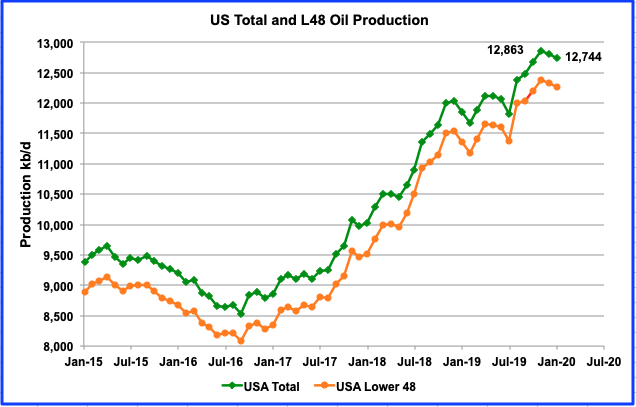Home » Posts tagged 'oil price' (Page 7)
Tag Archives: oil price
Historic Oil Crash Sends Canadian Oil Prices Negative
Historic Oil Crash Sends Canadian Oil Prices Negative
When Goldman’s crude oil analysts turned apocalyptic last month, writing that “This Is The Largest Economic Shock Of Our Lifetimes“, they echoed something we said previously namely that the record surge in excess oil output amounting to a mindblowing 20 million barrels daily or roughly 20% of the daily market…
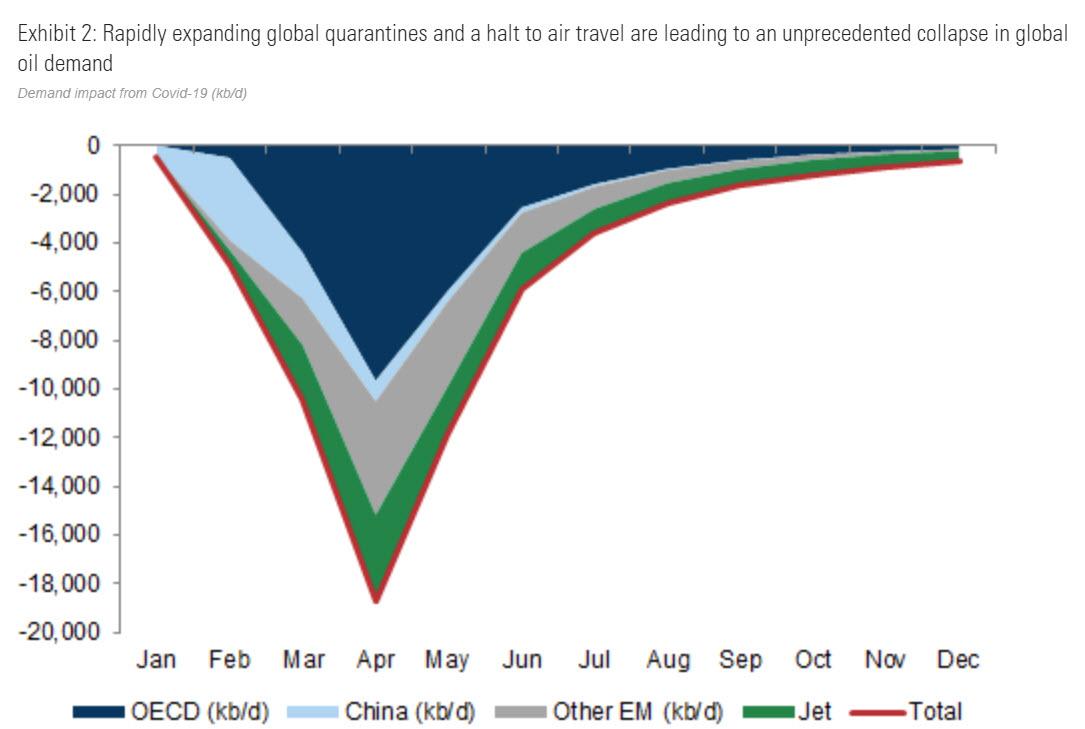
… the result of the historic crash in oil demand (estimated by Trafigura at 36mmb/d) which is so massive it steamrolled over last week’s OPEC+ 9.7mmb/d production cut, could send the price of landlocked crude oil negative: “this shock is extremely negative for oil prices and is sending landlocked crude prices into negative territory.”
We didn’t have long to wait, because while oil prices for virtually all grades have now collapsed below cash costs…
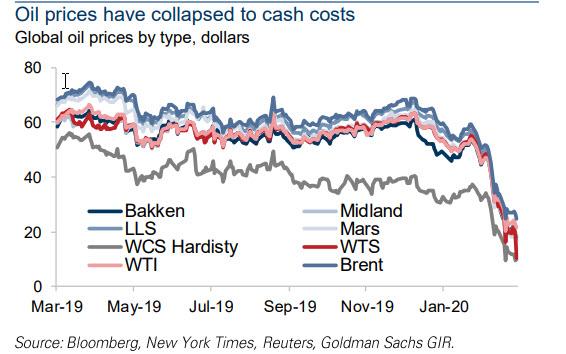
… today’s historic plunge in WTI – the biggest on record – which sent the price of the front-month future freefalling 40% to just $10/barrel…
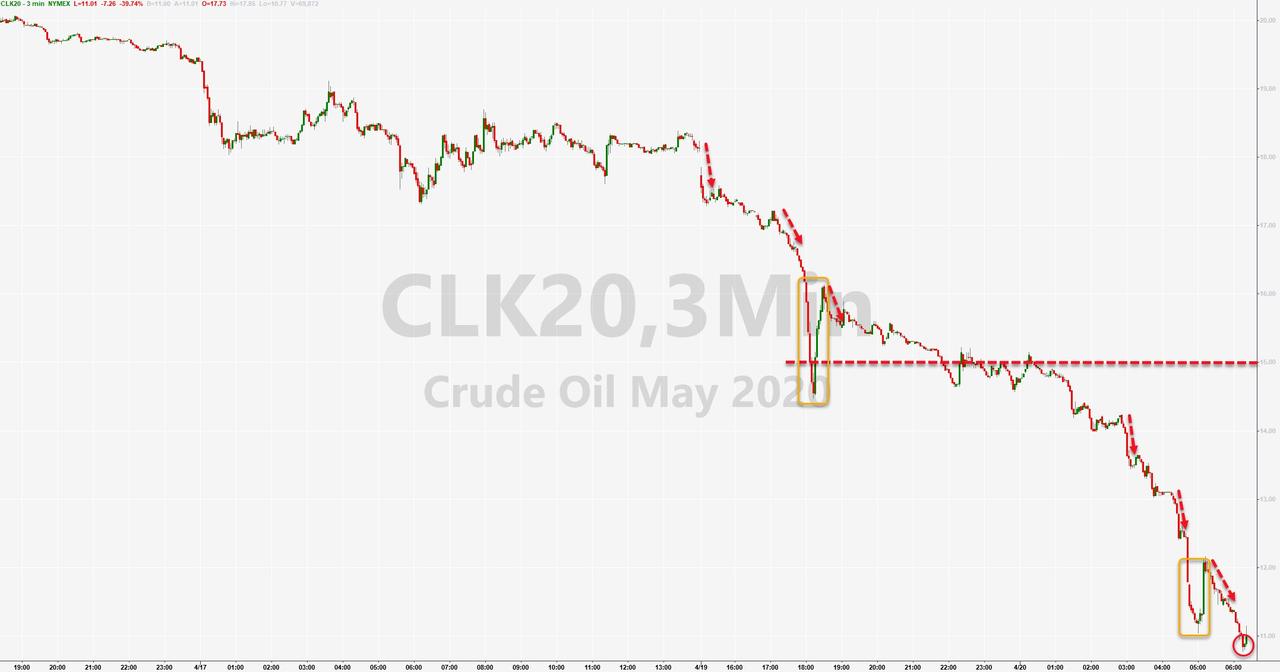
… has resulted in selected Canadian crude oil prices now officially turning negative with Canada’s Edmonton C5 Condensate deep in the red…
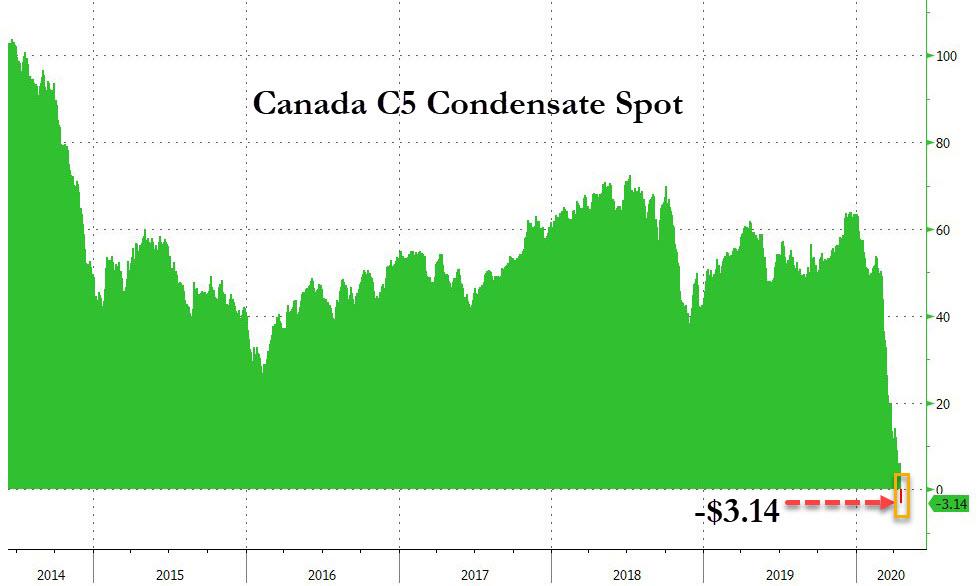
… while the Edmonton Mixed Sweet Blend dipped briefly negative for the first time ever before fractionally rebounding in the green.
Futures Plunge As WTI Crashes By Most On Record, Tumbling To $11 Per Barrel
Futures Plunge As WTI Crashes By Most On Record, Tumbling To $11 Per Barrel
Oil prices crashed the most on record with the May WTI futures contract hitting its lowest level since 1999, plunging as low as $11 or down 38%, as nobody wants to take actual physical storage amid widespread fears crude storage will soon be full; meanwhile companies prepare to report the worst quarterly earnings since the financial crisis, while tens of thousands of people continue to get sick every day with the coronavirus.

While Brent was only down $1.12, or 4%, at $26.96 a barrel on Monday morning, the carnage took place in the landlocked WTI, whose May contract fell $5.70 to its lowest since March 1998 though the sell-off was exaggerated by the contract’s Tuesday expiry because no one wants to be left long to take delivery as there is nowhere to put the physical product. In any case, the 37% drop was the biggest one-day drop on record!

“The May contract is set to expire tomorrow and the bulk of the open interest and volume is already in the June contract,” said ING’s head of commodities strategy, Warren Patterson. To be sure, the June contract, which is more actively traded, fell only $2.18, or 8.7%, to $22.85 a barrel, sending the prompt spread to a record $11/barrel.
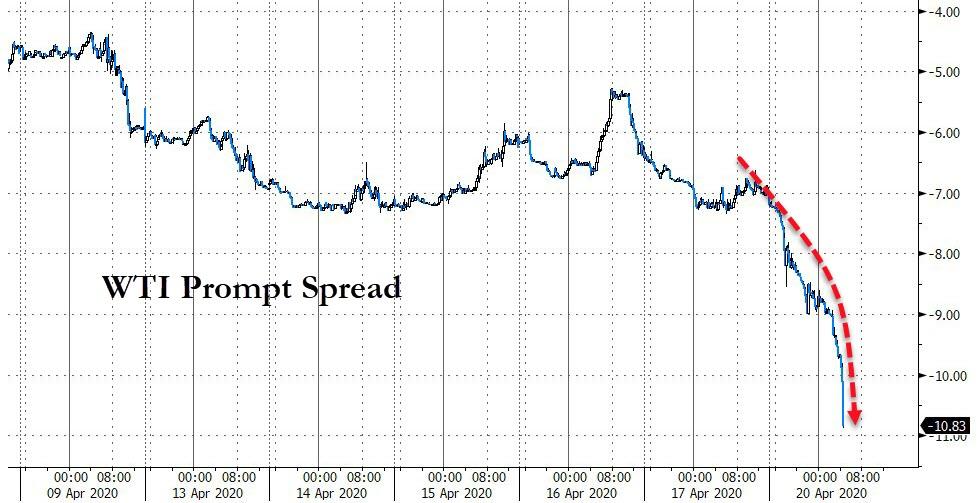
Not helping oil was an interfax report that Russia increased oil output by almost 1% in the last 3-days. While the OPEC+ deal comes into effect on May 1st, Russia is not bound by the pact to reduce its output until then; and – it appears – Moscow is looking to make the most of the next 10 days, even if it means sending the front-end to zero.
…click on the above link to read the rest of the article…
WTI Crashes To 19 Year Low As Trading Reopens; S&P Futures Slide
WTI Crashes To 19 Year Low As Trading Reopens; S&P Futures Slide
After a relatively drama-free weekend, futures have started off the new week lower by about 0.4%, trading at 2850, down 20 points from Friday’s CTA inspired and momentum-driven meltup which appears to be reversing as algos realize they have frontrun a rebound in not just 2021 earnings but also 2022 and 2023.
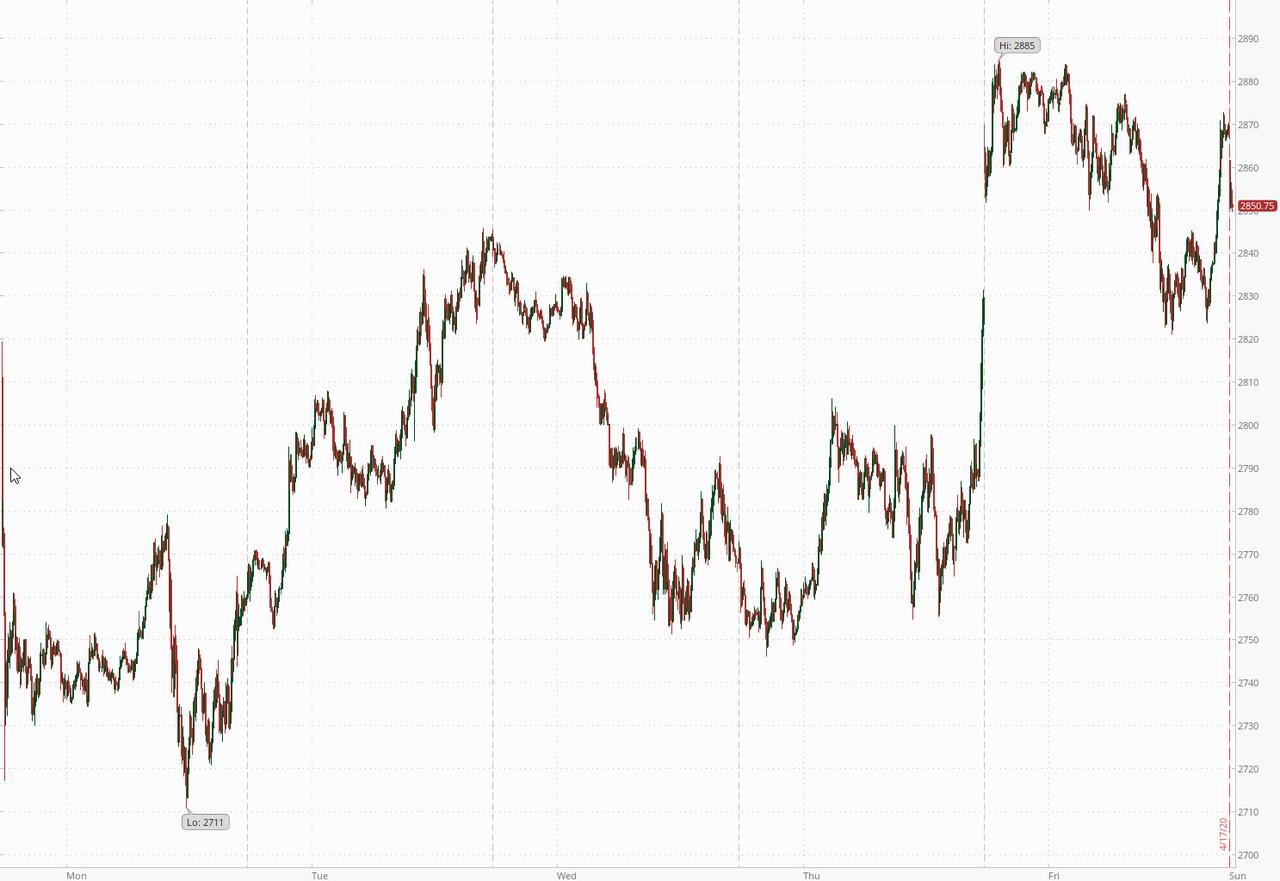
However, just like last week, it is commodities and specifically oil where the deflationary puke is taking place, with WTI tumbling over 5% at the open, and sliding to $17.30, down more than $10 from last Monday’s post OPEC+ kneejerk reaction higher and the lowest price since November 2001,
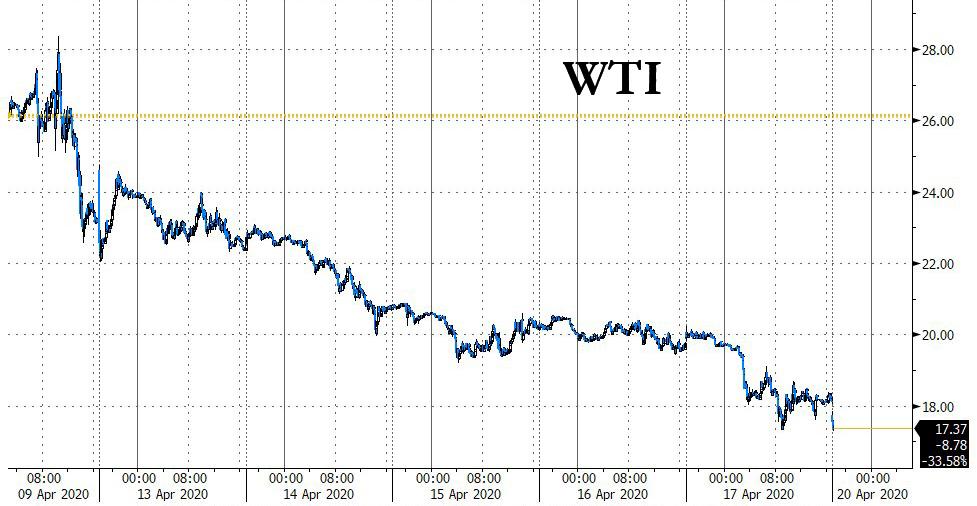
The ongoing crash in oil which OPEC+’s agreement to cut 9.7mmb/d in output last weekend has failed to halt, takes place as Crude prices in the US oil capital are getting dangerously close to zero. According to Bloomberg buyers bidding for crude in landlocked sections of Texas, ground zero of the shale revolution, are offering as little as $2 a barrel for some oil streams, a precipitous markdown from a month ago. And, as discussed here on various occasions, the plunging value of physical barrels is raising the possibility that Texas producers may soon have to pay customers to take crude off their hands.
Negative prices already hit more obscure corners of the North American oil market amid a bearish trifecta of collapsing demand, swelling supplies and limited storage capacity. AS we reported at the end of March, the first U.S. grade to bid under zero was a small landlocked crude stream known as Wyoming Asphalt Sour, which went for negative 19 cents a barrel last month.
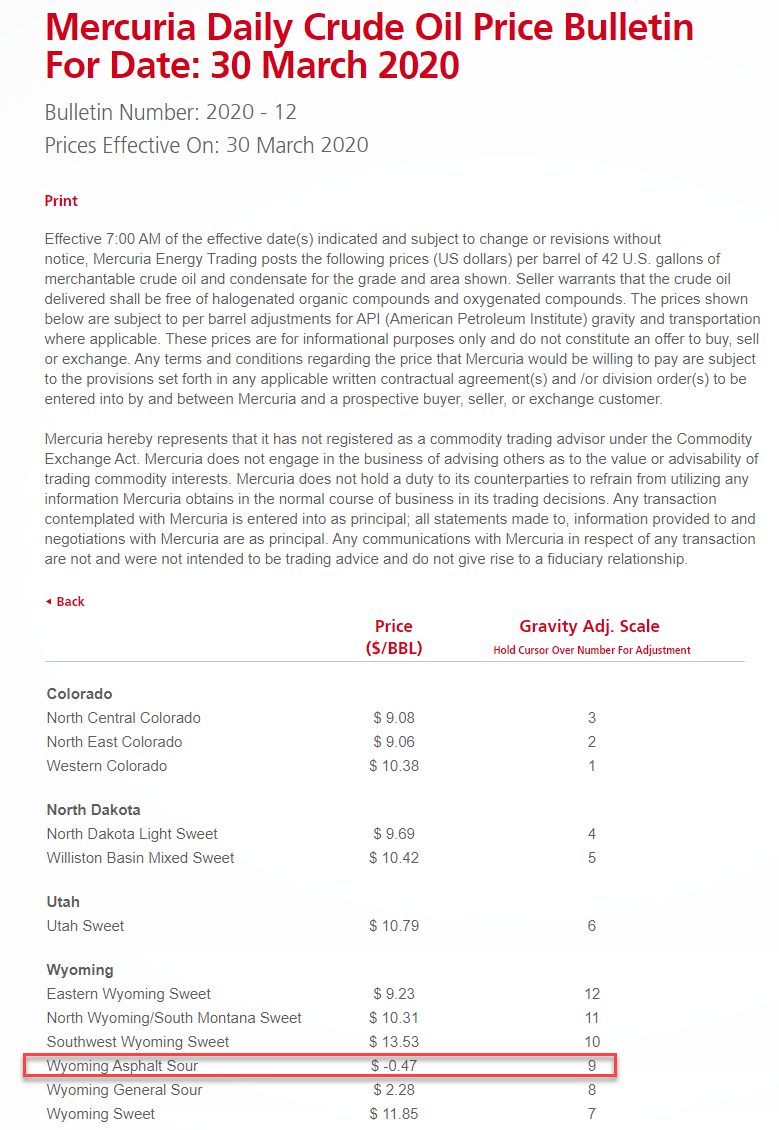
Meanwhile, in Texas prices are heading in that direction. A subsidiary of Plains All American Pipeline bid just $2 a barrel for South Texas Sour on Friday, while Enterprise Products Partners LP offered $4.12 for Upper Texas Gulf Coast crude this week, according to Bloomberg.
For Oil and Its Dependents, It’s Code Blue
For Oil and Its Dependents, It’s Code Blue
The great price collapse of 2020 will topple companies and transform states.
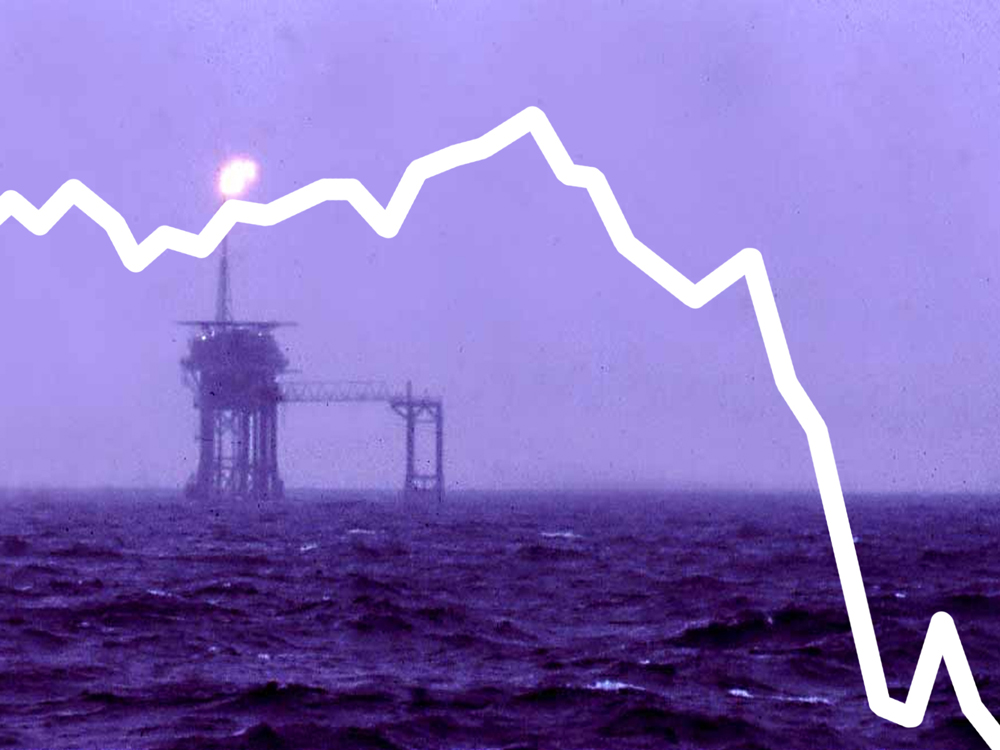
If oil has been laid low by the coronavirus, then the nations whose economies most depend on it might soon be on ventilators. By any prognosis the great oil price collapse of 2020 has pushed the world’s most volatile commodity into Code Blue.
No one expects oil, its peddlers or consumers to emerge wealthier or wiser from this crisis. Oil company bankruptcies, already happening before the pandemic, will escalate. And more petro states will begin to stumble, like Venezuela, down the rabbit hole of collapse.
The pandemic, combined with suicidal overproduction and a brief price war between Russia and Saudi Arabia, has reduced oil consumption and revenues on a scale that is mindboggling.
Prior to the pandemic, the world gulped about 100 million barrels a day, filling the atmosphere with destabilizing carbon. Today it sips somewhere between 65 million and 80 million barrels.
At least 20 to 30 per cent of global demand has vanished and nearly two dozen petro-producing countries including Canada have agreed to withhold nearly 10 million barrels from the market. Few expect this agreement will stop the price bleeding.
In fact, the price of Western Canadian Select or diluted bitumen remains below five dollars a barrel — cheaper than hand sanitizer. That’s a drop of more than 80 per cent compared to the month before.
Because the spending of oil fertilizes economic growth and expands national GDPs, most of the world’s economists now predict a long depression after the pandemic.
…click on the above link to read the rest of the article…
Canadian Oil Sands Per Barrel At $4.47, Now Cheaper Than 12-Pack Coke, $5.08
Canadian Oil Sands Per Barrel At $4.47, Now Cheaper Than 12-Pack Coke, $5.08
The collapse of global oil demand has impacted the price of Canadian Oil Sands to such a degree, the price of a barrel is now cheaper than a 12-pack of Coke purchased at Walmart. According to oilprice.com, the current price of a barrel of Western Canadian Select (oil sands) is $4.47 versus a 12-pack of Coke at Walmart for $5.08.

What a deal… ah? Now, let’s do a simple comparison of the ENERGY CONTENT in a barrel of Canadian Oil Sands vs. a 12-pack of Coke. A barrel of oil equivalent contains 1.4 billion calories of energy. A typical 12 oz Coke can contains 140 calories. If we multiply it by 12, we have 1,680 calories in a 12-pack of Coke.
Doing some simple math:
Barrel Of Oil Equivalent (1,400,000,000 calories) / 12-Pack Coke (1,680 calories) = 833,333.
Thus, a barrel of Canadian Oil Sands, which contains 833,333 times the energy calories than a 12-pack of Coke, is now worth $4.47 compared to $5.08 for the 12-pack of Coke. Again… what a deal, ah??
I just wanted to post this simple comparison to show how much the Global Oil Industry is being gutted. If OPEC, Russia, and the United States do not come up with “MEANINGFUL CUTS,” then we could see Western Canadian Select trading for $1 a barrel or less.
As for RESTARTING the U.S. and Global Economy after an extended shutdown, I have my doubts, as so does Gail Tverberg at her blog, OurFiniteWorld.com. Check out her most recent article; Economies won’t be able to recover after shutdowns.
COMING NEW VIDEO: I am finishing putting together the charts for my next video on why the GOLD & SILVER PRICES will explode due to the collapse of the Global Financial Ponzi Scheme.
WTI Extends Losses Below $20 After Record Surge In Crude Inventories
WTI Extends Losses Below $20 After Record Surge In Crude Inventories
WTI crashed below $20 (tagging $19.20) overnight after API reported huge inventory builds and was not helped by comments from the International Energy Agency that a historic production cut deal won’t be enough to counter a record demand slump this year.
This appears to confirm a key gauge of the oil market’s health which is at its weakest in more than a decade as supplies build and futures contracts roll over. West Texas Intermediate crude for May delivery traded at more than $7 a barrel below its June contract on Tuesday, the deepest contango since 2009. The May contract is nearing expiration and exchange-traded funds, including the United States Oil Fund, have been selling front-month contracts and buying second-month futures.
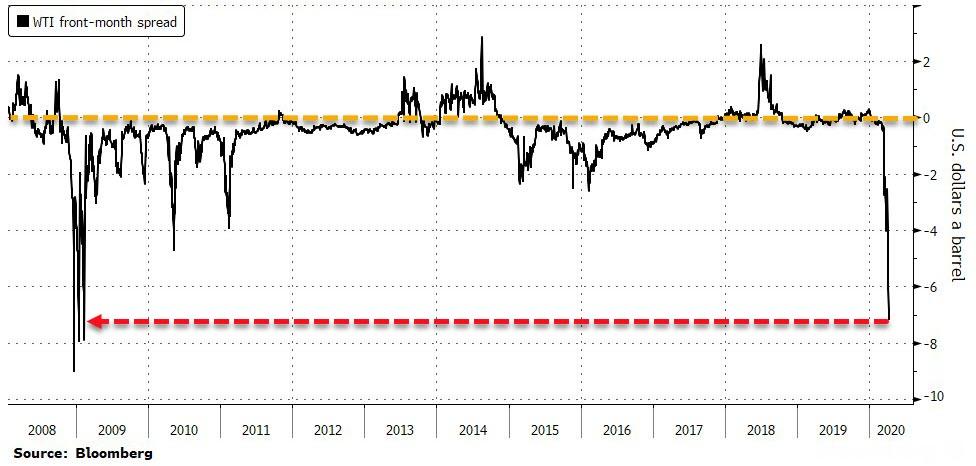
Simply put, this is an indication of extreme oversupply.
“At least over the next month or so, before these cuts have an opportunity to kick in, we are going to be very stressed on inventories,” Bart Melek, head of commodity strategy at TD Securities, said by telephone.
And so all eyes are once again on the inventories for any positive signs…
API
- Crude +13.143mm (+10.1mm exp)
- Cushing +5.361mm
- Gasoline +2.226mm (+7.1mm exp)
- Distillates +5.64mm (+1.8mm exp)
DOE
The Saudi-Russian oil price war tag team: Are things what they seem?
The Saudi-Russian oil price war tag team: Are things what they seem?
To the casual observer Saudi Arabia and Russia, two of the top three producers of oil in the world, have been having a spat about what to do about low oil prices. (See here and here.) Each has accused the other of bad faith and counterproductive behavior. But is that merely what the two oil powers want you to believe?
We’ve been here before. Throughout most of 2016 Saudi Arabia and Russia put on a two-person show for the entire world, pretending time after time to move close to an agreement to lower production in order to prop up oil prices, only to back away or delay at the last minute. The two kept this up for most of 2016. They incited periodic spikes in the oil price without ever having to cut one barrel of production, spikes that kept prices higher for weeks until they drifted back down to levels that reflected reality.
But I believe the most important thing they were trying to achieve then was to create an atmosphere of continuing uncertainty. That uncertainty was supposed to scare investors and lenders away from U.S. shale oil producers who were still hurting from an oil price collapse that began at the end of 2014. Saudi Arabia and Russia wanted to prevent those producers from resurrecting U.S. production and undermining oil prices again. Simply stated, Saudi Arabia and Russia wanted the shale oil industry to go bust in a way that would prevent a recovery for many years.
But investors and lenders could not be frightened away, and they resumed financing shale oil operations in the United States.
…click on the above link to read the rest of the article…
In Late Thriller, OPEC Production Cut Deal Collapses After Mexico Gives Crown Prince The Finger
In Late Thriller, OPEC Production Cut Deal Collapses After Mexico Gives Crown Prince The Finger
Earlier today we reported that following a dramatic objection to the OPEC+ production cut which was agreed upon by Russia and Saudi Arabia (but few other OPEC members), Mexico had initially threatened to quit OPEC as it refused to comply with the imposed 23% cut forced on all members, but less than an hour later the southern US neighbor reportedly had changed its mind as Reuters reported that Mexico had in fact agreed to the OPEC+ production cut deal after all.
Well, scratch all that because it appears the Reuters “news” was fake, sourced from some conflicted Saudi minister who wanted to put Mexico in a position where it had no choice but to accept the reality that had been imposed upon it. Unfortunately for the Saudis, this “plan” was laughable and late on Thursday, Mexico logged off the OPEC+ alliance’s videoconference emergency meeting after nine hours of talks Thursday, without agreeing to the landmark 10 million b/d production cut accord that members were hoping could stem a bruising rout in oil prices caused by the coronavirus pandemic and send the price of oil surging, S&P Global Platts reported, whose sources we can now confirm are far more credible than those of Reuters.
The rest of the coalition, led by Saudi Arabia and Russia, were in discussions over how to proceed, with many ministers angry over the potential blow-up of the deal. The coalition will likely try to convince Mexico again Friday at a G20 energy ministerial that was originally scheduled to seek the participation of the US, Canada, Brazil and other key producers outside of OPEC+ to join its efforts.
…click on the above link to read the rest of the article…
Oil Spikes After Russia Says Ready For “Substantial Output Cut”, But Warns 10MMb/d Cut Not Enough
Oil Spikes After Russia Says Ready For “Substantial Output Cut”, But Warns 10MMb/d Cut Not Enough
Over the weekend, following the biggest ever oil short-squeeze in history following rampant hopes that Saudi Arabia and Russia were considering putting their differences aside and cutting up to 10mmb/d in oil output, we said that in a world where oil demand has plunged by as much as a quarter due to the coronavirus pandemic, or as much as 26mmb/d, such a cut would “not be nearly enough to balance the oil market but at least it was a start.”
Then, moments ago, oil which had been drifting in Monday’s session after the report that a new burst of animosity between Saudi Arabia and Russia has pushed back today’s virtual R-OPEC meeting to later in the week, oil spiked after a Reuters rehash of headlines over the past 3 days, namely that Russia is ready to discuss very substantial oil output cuts “due to global demand collapse“, but – just as we warned over the weekend – Russia dded that “global oil output cuts of 10mmbpd might not be enough to balance the market.”
Well, yeah: with demand down 26mmb/d, supply would have to drop by a similar amount to balance the market.

As a result, Dow Jones reported separately that Saudi Arabia has also invited non-OPEC member Norway, UK and Brazil to the summit in hopes of getting everyone nation to agree to cut output, not just R-OPEC and potentially US shale producers. And as DJ also added citing sources, according to OPEC Plus – which now hopes to hold its summit on Friday – the output cuts would be contingent on G-20 cooperation. In short, while Saudi Arabia destroyed OPEC when it flooded the world with oil last month, it now hopes to not only recreate the oil producing cartel to include every single oil producing nation in the world but to convince said cartel to ease production.
The OPEC Meeting Could Send Oil Prices Crashing Below $10
The OPEC Meeting Could Send Oil Prices Crashing Below $10

The current optimism of analysts and the media that an end to the ongoing OPEC+ oil price spat is near is entirely unjustified. The ongoing oil market volatility, the battle between leading producers for market share, the logistical impossibility of enforcing U.S. production cuts, and the continued demand destruction caused by COVID-19 are not issues that can be solved by an OPEC meeting. Immediately after Trump’s latest OPEC twitter offensive, Saudi Arabia and Russia came out with critical statements about the impact and influence of the US president on the matter. While Putin and Mohammed bin Salman are reluctant to bash Trump, the real power when it comes to the oil market does not lie with the U.S. President. The tweet by Trumpclaiming that MBS and Putin would agree to a 10+ million bpd production cut shows not only his overestimation of his own power over the two countries, but also shows a lack of knowledge about the underlying market fundamentals and the current demand destruction worldwide. As former US president George W. Bush stated during his election campaign, which did not end well as we know, “it’s the economy stupid” that matters in the end. Trump’s tweets and general approach to this matter suggests he and his administration are out of touch with reality. Even if a Saudi-Russian combination would cut 10 million bpd, the oil price reaction would be minimal and very short-lived. At present, leading oil market experts such as Vitol, Trafigura and Goldman Sachs are warning of a total demand destruction of 20 million bpd or more.
…click on the above link to read the rest of the article…
WTI Extends Losses After Biggest Crude Build Since 2016
WTI Extends Losses After Biggest Crude Build Since 2016
After its worst quarter ever, as COVID-19 lockdowns crushed demand, raising fears about overflowing storage tanks amid a price war that has flooded the market with extra supply, all eyes are glued to today’s official inventory data (after API reported a major surprise build in crude and gasoline stocks) as Standard Chartered analysts, including Emily Ashford warned in a report, oil tanks around the world could fill in six weeks, a move that will likely force significant production shut-downs,
“Huge inventory builds, potentially exhausting spare storage capacity, will mean that market balance requires an unprecedented output shutdown by producers,” they wrote.
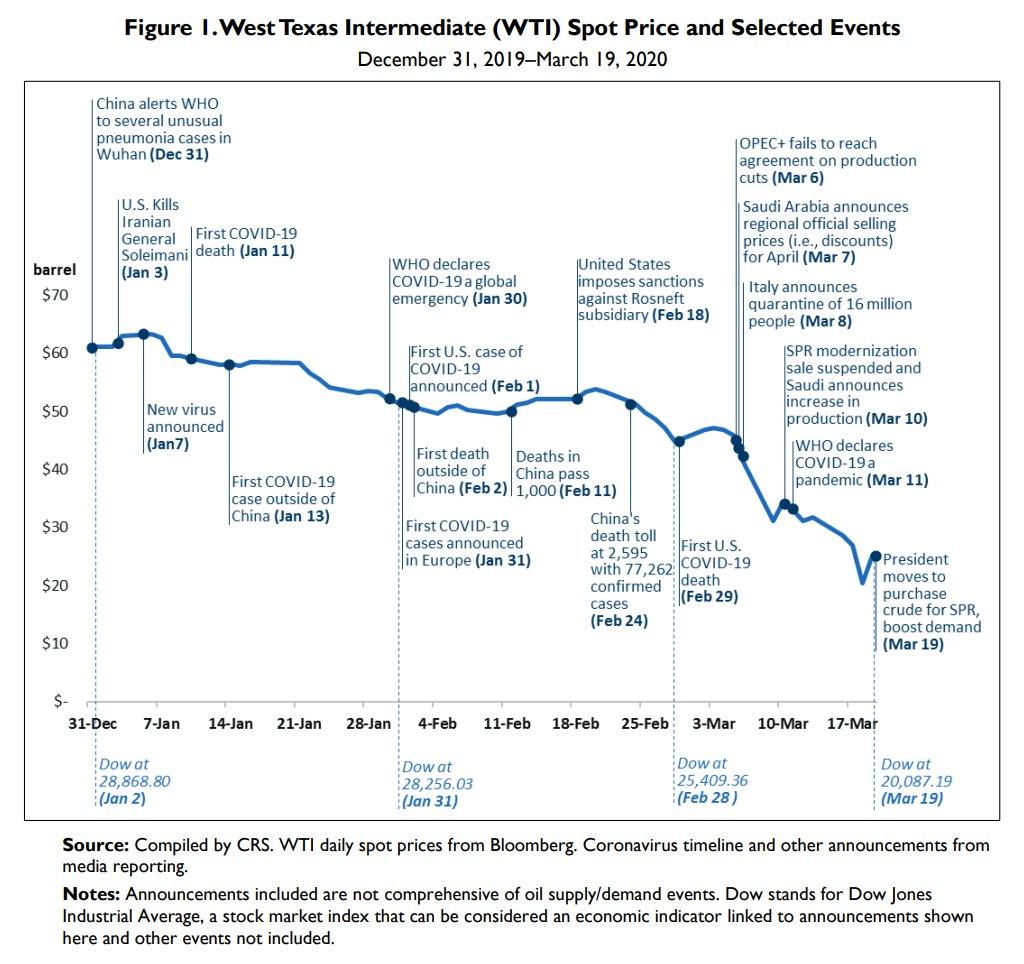
So, eyes down…
“There is the very real possibility that this week’s storage reports could be the energy patch version of last Thursday’s Weekly Jobless Claims,” Robert Yawger, Mizuho Securities USA’s director of energy said in a note.
“I would expect the numbers to be supersized and challenge multi-year highs/lows on multiple data points. Of course, I have been expecting big numbers for the past couple week, but the fireworks have not happened. That leads me to believe that the data explosion will likely happen this week … Exports will likely be down big, and refinery utilization will likely pull back dramatically. That will leave a lot of crude oil on the sidelines … EIA crude oil storage has been higher for nine weeks in a row. Storage will likely double up and increase at the rate of around 10 million for another nine weeks…at least.”
API
- Crude +10.485mm (+4.6mm exp) – biggest build since Feb 2017
- Cushing +2.926mm – biggest build since Feb 2019
- Gasoline +6.058mm (+3.6mm exp) – biggest build since Jan 2020
- Distillates -4.458mm (-600k exp)
DOE
- Crude +13.833mm (+4.6mm exp) – biggest since Oct 2016
- Cushing +3.521mm – biggest build since Mar 2018
- Gasoline +7.524mm (+3.6mm exp) – biggest build since Jan 2020
- Distillates -2.194mm (-600k exp)
Texas Or Canada: Where Will Oil Hit $0 First
Texas Or Canada: Where Will Oil Hit $0 First
Looking at the future of oil prices, Goldman was downright apocalyptic in its short-term forecast, when in a note published this morning, the bank’s chief commodity strategist Jeffrey Currie speculated that as the current production glut “shock” cripples the crude transportation networks, “a producer would be willing to pay someone to dispose of a barrel, implying negative pricing in landlocked areas.” To wit:
The global economy is a complex physical system with physical frictions, and energy sits near the top of that complexity. It is impossible to shut down that much demand without large and persistent ramifications to supply. The one thing that separates energy from other commodities is that it must be contained within its production infrastructure, which for oil includes pipelines, ships, terminals, storage facilities, refineries, and distribution networks. All of which have relatively small and limited spare capacity. We estimate that the world has around a billion barrels of spare storage capacity, but much of that will never be accessed as the velocity of the current shock will breach crude transportation networks first, which we are already seeing evidence of around the world. Indeed, given the cost of shutting down a well, a producer would be willing to pay someone to dispose of a barrel, implying negative pricing in landlocked areas.
A quick look at two of the most popular landlocked oil producing areas demonstrate that Goldman is spot on, and as the following chart shows as of this moment Texas Midland WTI was trading at just baove $10/barrel, while the price of oil produced in the notoriously landlocked Western Canada, as represented by Canada Western Selected index, was just above $4 per barrel, or a little more than what a gallon of gas costs in California.
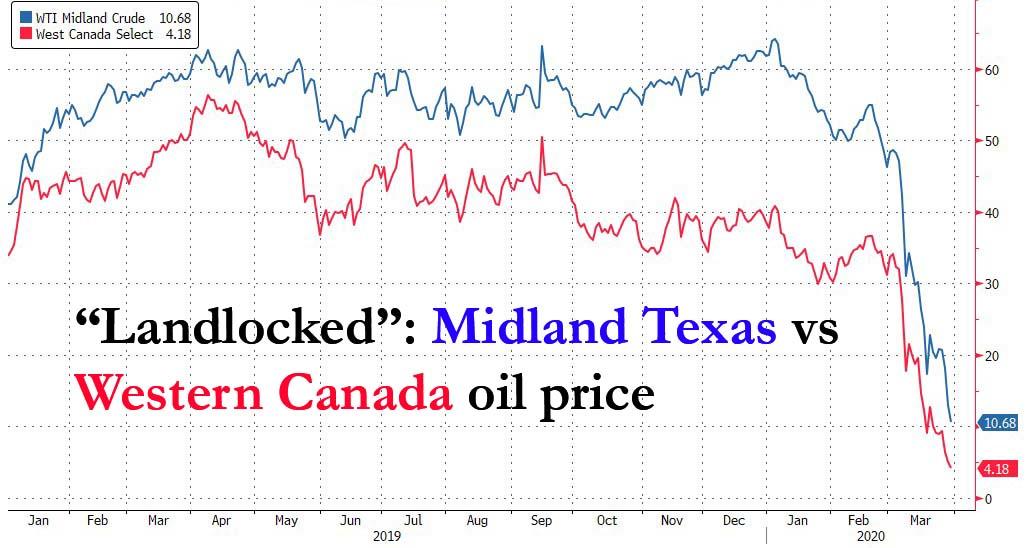
The Unthinkable Is Happening: Oil Storage Space Is About To Run Out
The Unthinkable Is Happening: Oil Storage Space Is About To Run Out
In the past three weeks, oil plunged and has continued to plunge even more in the aftermath of the oil price war declared between Saudi Arabia and Russia, and where US shale (and its junk bonds) has been caught in the crossfire. However, as we reported last week, we may get to the absurd point when the price of a barrel of oil not only hits $0 but goes negative.
The reason: according to Mizuho’s Paul Sankey, at a whopping 15MM b/d in oversupply, crude prices could go negative as Saudi and Russian barrels enter the market. According to Sankey, much of the US 4MM bpd in crude exports will be curtailed as prices fall and tanker rates soar. And with US storage roughly 50% full, and able to take another 135MM bbl more, assuming a build rate of 2MM b/d, the US can add 14MM bbl/week for 10 weeks until full.
As a result, there is a now race between filling storage and negative pricing “unless U.S. decline rates can outpace inventory builds, which we very much doubt.” Said otherwise, absent dramatic changes, in roughly 3 months, energy merchants will be paying you if you generously take a couple million barrels of crude off their hands.
It went from bad to an outright disaster earlier this week when Goldman, Vitol, and the IEA all raised their estimate for daily oil oversupply to an unthinkable 20 million barrels per day, as a result of the collapse in oil demand as the global economy grinds to a halt coupled with Saudi Arabia’s determination to put all of its higher-cost OPEC peers out of business.
…click on the above link to read the rest of the article…
What Happens If Oil Prices Go Negative?
What Happens If Oil Prices Go Negative?

Various reports hit the news feeds today quoting a deliberately headline-grabbing statement by Paul Sankey, managing director at Mizuho Securities, in which he is reported as saying, “Oil prices can go negative.” That is, they could as a combination of Saudi Arabia (and Russia) flooding the market with increased oil and the market running headlong into COVID-19-induced curtailment of activity that is suppressing consumption, which combined will create the perfect storm of excess supply.
In reality, inventory levels are already rising.
CNN quotes Sankey, who said global oil demand is only around 100 million barrels per day.
However, the economic fallout from the coronavirus pandemic could crash demand by up to 20 percent.
This would create a 20 million barrel-per-day surplus of oil in the market that would rapidly exceed storage capacity, forcing oil producers to pay customers to buy the commodity – hence, in effect, negative oil prices.
The American government plans to purchase a total of 77 million barrels of oil starting within weeks the article states, but according to Sankey, this can only be done at a rate of 2 million barrels per day, leaving a massive excess that will be looking for a home.
Brent oil prices have already fallen to the lowest level for 17 years. The consequences for the U.S. oil industry if a coronavirus-induced recession drives down demand could be catastrophic.
West Texas Intermediate crude (WTI) collapsed by a staggering 19.2 percent to $22 while the Mexican Basket is down 22.4 percent.
For a short while, hedges will protect producers and they will continue to pump oil. While that will protect producers for a while, it encourages counter-cyclical practices; producers should be cutting back but instead will probably continue to pump and ship into store.
…click on the above link to read the rest of the article…


